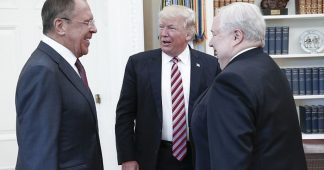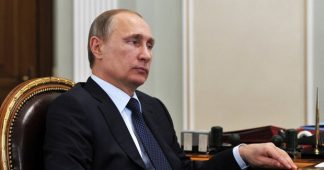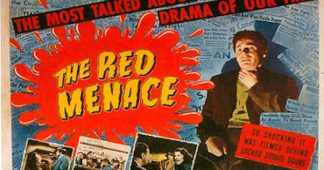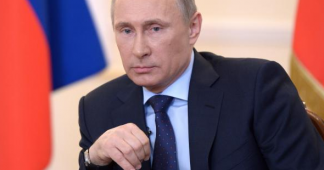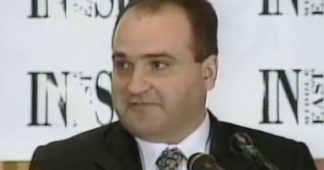Russiagate may have been aimed at Trump to start, but it’s become a way of targeting all dissent
By Matt Taibbi
March 06, 2018
Putin loves you; therefore, you love Putin. The enemy re-tweets you, therefore, you’re in league with the enemy. We’re at war with them, therefore we’re at war with you.
One of the first rules of a shunning campaign is that it doesn’t have to make sense. It just has to be what everyone’s saying. Since most Americans went to high school, we tend to be instinctively familiar with the concept.
The crazy inverse logic of the new national blacklist was on full display after special prosecutor Robert Mueller indicted 13 Russian “troll farm” operatives in February. In the wake of this foreign meddling charge, CNN reporter Drew Griffin banged on the door of an elderly female Trump supporter named Florine Goldfarb and accused her of being a Russia-collaborator.
Goldfarb had attended a pro-Trump rally allegedly promoted on Facebook by Russian trolls. There were no Russians at the rally. The group didn’t meet to discuss the subjugation of Abkhazia. They were plain, ordinary, Floridian Trump supporters – idiots, maybe, but not traitors.
Not according to CNN.
“That group was Russians,” Griffin said accusingly.
“I had nothing to do with Russians,” the old lady said.
“Maybe you didn’t know it,” Griffin countered, “but you did.”
Nearly two years into the #Russiagate scandal, accusing people of being in league with Putin has become an almost daily feature of news coverage.
“Is it possible that we actually have a Russian agent running the House Intel Committee on the Republican side?” MSNBC anchor John Heilmann posited not long ago, referring to California congressman Devin Nunes.
The main source of the questions about Nunes was Hamilton 68, a website purporting to track the work of Russian social media bots in real time. An offshoot of the German Marshall Fund, the site represents an unpleasantly unsurprising union of neoconservative Iraq war cheerleaders like Bill Kristol and Beltway Democrats like would-be Clinton CIA chief Michael Morell.
Their Hamilton 68 “dashboard,” easily accessible online to civilians and journalists alike, supposedly tells us what the enemy wants us to think at any given moment. Citing a secret methodology, it claims to track 600 Twitter accounts for their “relationship to Russia-sponsored influence,” and regularly spits out mysterious conclusions about Putin’s preferences in the American political scene. More and more often now, the site’s pronouncements turn into front-page headlines.
When the dashboard declared that Nunes’ #Releasethememo campaign had become the “top-trending hashtag” among Russian twitter accounts, a gaggle of press outlets and politicians rushed to point out that Nunes was doing the work of the enemy. (Even Rolling Stone got into the act, accusing Nunes of working “in concert with Russian propagandists”).
Of course, in keeping with a growing pattern of Russiagate stories being quietly walked back sometime after the sensational headline, reports later broke that most of the Twitter furor driving #Releasethememo came from domestic Republicans – from “inside the house,” as the Daily Beast put it. Even one of Hamilton 68’s own was later quoted downplaying the story.
It didn’t matter, because Hamilton 68 had by then moved on to its next set of headlines. The group that has seen Russians behind both left and right political causes, behind the Roy Moore Alabama Senate campaign and the decision of California Democrats to deny their endorsement to Dianne Feinstein, was soon a main source for stories about Russians playing havoc with the Parkland shooting in Florida.
The Russians, Hamilton 68 now said, were sowing discord on both sides of the gun control debate by pushing contradictory hashtags like #guncontrolnow and #NRA.
The New York Times put a piece about Russia’s Parkland meddling on page A1, the choicest real estate in American journalism, and outlets like Wired, Newsweek, Vanity Fair and countless others trumpeted the same story. Even Fox News, usually a Russiagate doubter, got in the act, citing Hamilton 68 to say: “Russian bots aren’t pro-Republican or Pro-Democrat. They’re just anti-American.”
Fox wrote the story in a way that used the Hamilton 68 data to make it seem like the Russians didn’t have an exclusive preference for Donald Trump. But the defense of Trump was really a distraction. The palmed card in this propaganda trick was the mere fact that right-wing media, too, were now accepting the core principle of projects like Hamilton 68: that a foreign enemy lurks everywhere in our midst, and the source of political discontent in this country comes not from within, but from without.
This Russians-are-in-our-precious-bodily-fluids insanity has progressed to the point where an anti-Russian documentary won the Oscar and host Jimmy Kimmel proudly declared, “At least we know Putin isn’t rigging this competition!”
If you don’t think that the endgame to all of this lunacy is a world where every America-critical movement from Black Lives Matter to Our Revolution to the Green Party is ultimately swept up in the collusion narrative along with Donald Trump and his alt-right minions, you haven’t been paying attention.
That’s because #Russiagate, from the start, was framed as an indictment not just of one potentially traitorous Trump, but all alternative politics in general. The story has evolved to seem less like a single focused investigation and more like the broad institutional response to a spate of shocking election results, targeting the beliefs of discontented Americans across the political spectrum.
Two years ago, remember, the American political establishment was on the ropes. Donald Trump, a race-baiting game show host who’d run for office as a publicity stunt, was galloping to the Republican nomination in a rout. He got 14 million primary votes; the Republicans’ chosen $100 million man, Jeb Bush, got 286,000. On the Democratic side, the overwhelming party favorite, Hillary Clinton, was fighting to hold off a Corbynite socialist with little money and even less institutional support.
From Trump to Bernie Sanders to Brexit to Catalonia, voter repudiation of the status quo was the story of the day. The sense of panic among political elites was palpable. The possibility that voters might decide to break up the EU, or put a Trump, Corbyn, or Sanders into power, led to a spate of “Do we have too much democracy?” essays by prominent think tankers and national press figures.
Two years later, the narrative has completely shifted. By an extraordinary coincidence, virtually all the “anti-system” movements and candidates that so terrified the political establishment two years ago have since been identified as covert or overt Russian destabilization initiatives, puppeteered from afar by the diabolical anti-Western dictator, Vladimir von Putin-Evil.
Since Trump’s election, we’ve been told Putin was all or partly behind the lot of it: the Catalan independence movement, the Sanders campaign, Brexit, Jill Stein’s Green Party run, Black Lives Matter, the resignations of intra-party Trump critics Bob Corker and Jeff Flake, Sean Hannity’s broadcasts, and, of course, the election of Trump himself.
We’ve jumped straight past debating the efficacy of democracy to just reflexively identifying most anti-establishment sentiment as illegitimate, treasonous, and foreign in nature.
Forget for a moment what Robert Mueller’s investigation might or might not ultimately reveal about Donald Trump and his staff. It’s been impossible not to notice how effective the Russiagate affair has already been as a hammer against all other political outsiders, even those with opposite values to Trump. In fact, unless you’re a Hillary Clinton Democrat, you’ve probably been portrayed as having somehow been in on it, at one time or another.
The earliest Russiagate news reports, like Franklin Foer’s articles in Slate in the summer of 2016, mostly focused on Putin’s seeming synergy with far-right causes: the Trump campaign in America, and nationalist, anti-EU movements in states like Greece, Bulgaria, and Hungary.
Very quickly, though, the Russiagate narrative evolved to describe leftists, libertarians, and other assorted malcontents as additional “useful idiots” for Putin. This really began with the ill-fated “PropOrNot” web site, a mysterious organization that was touted as an identifier of Russian propaganda in a story by the Washington Post three weeks after Trump’s election
The Post’s carefully-written piece only talked about how PropOrNot and other groups identified Russian propaganda spread on “right-wing sites.” But if you clicked on the paper’s link to the PropOrNot report, you found it pointed a finger at over 200 sites of all political persuasions. Those included outlets as diverse as LewRockwell.com, Truthdig, Naked Capitalism, Antiwar.com, and the Ron Paul Institute.
That was followed by the release of a report by the Director of National Intelligence on January 6, 2017, which “assessed” that Russians were behind the hacks of the Democratic National Committee. The conclusion among other things was based upon the security agencies’ interpretation of programming on the Russian-backed channel RT.
RT stories about 100% American protests against fracking, surveillance abuses, and “alleged Wall Street greed,” were part of “Russian strategic messaging” campaigns, the intelligence analysts insisted.
The DNI’s bizarre assessment evolved with the birth of the German Marshall Fund, a Russia-watching organization similarly packed with former intelligence officials who bore the same cross-eyed conception of domestic protest.
The GMF’s Hamilton 68 project, which was launched in August of 2017, has in its brief life continually blurred the lines between domestic discord and foreign intervention. It’s accused the Russians of inspiring discontent about everything from police brutality to the Iraq invasion to the expansion of NATO. Think-tanks and pundits have increasingly followed suit, demanding that all good patriotic Americans renounce such “Putin-backed” protest movements.
A major target of this idiocy has been Sanders, who is already being pitched to the public as the Kremlin’s next Manchurian Candidate. “When Russia interferes with the 2020 election on behalf of Democratic nominee Bernie Sanders,” the Washington Post unironically asked last November, “how will liberals respond?”
Unless you really believe that Bernie Sanders is a Russian agent, it’s incredibly suspicious that a major consequence of the #Russiagate mania has been the disappearance of progressive voices from traditionally blue-state media.
Papers like the Washington Post and the New York Times, as well as cable channels like CNN and MSNBC, still routinely hire Republicans and even Trump supporters as commentators to provide “balance.” But there’s virtually no one in the popular press representing the 43% of Democrats who cast a dissenting vote two years ago.
Still, you might say, it’s all true! Russia did try to meddle in our election! We really are facing a foreign threat!
That might very well be. But the realness of a foreign threat in no way precludes Americans’ ability to make a total cock-up of their response to it. That we could forget this is amazing, since we so recently went through an exactly analogous disaster.
Six months after 9/11, on March 11, 2002, George W. Bush issued a directive creating a thing called the Homeland Security Advisory System. This oft-parodied program used a color-coded billboard system – because Americans are too stupid to read – to tell us just exactly how afraid of terrorists we should be on any given day.
For seven lunatic years we toggled back and forth between RED (severe threat) and GREEN (low threat) levels of paranoia, until in 2009 the program was quietly scrapped. By then we’d already blundered into Iraq, destabilized the entire Middle East, helped give birth to ISIS, and sacrificed countless American and Iraqi lives for no good reason at all, thanks in large part to cynical government efforts to hype up public fears of Islam.
The color advisory system was ditched only after former Homeland Security chief Tom Ridge wrote a book, Test of Our Times, that included a damning account of the program. Ridge revealed that in 2004, Attorney General John Ashcroft asked him to raise the threat level days before the presidential vote, in an effort to help guarantee George Bush’s re-election.
“There was absolutely no support for that position within our department,” Ridge wrote. “None. I wondered, ‘Is this about security or politics?'”
Ridge had never liked the system. When he resigned from the Department of Homeland Security in 2005, he told the press that his department often argued against raising the threat level, but was overruled by the Homeland Security Advisory Council, which included the heads of other security agencies.
Who was on that council? Creeps like Ashcroft, wraithlike Defense Secretary Don Rumsfeld, Secretary of State Colin Powell, and CIA chief George Tenet. Oh, and then-FBI director Robert Mueller, who also oversaw a sweeping effort to interview thousands of Arabs in America in a program that at the time was compared to our profiling of Japanese-Americans in World War II.
The Hamilton 68 “dashboard” almost exactly mirrors that Homeland Security Advisory program. It’s a snappy-looking media-ready thingamadoodle with no real purpose beyond constantly reminding the public to be afraid of enemies in their midst. And it’s run by many of the same ought-to-have-been-disgraced War on Terror yahoos who led us into the last mess.
Not only is the notorious Kristol of Weekly Standard and Project for a New American Century fame one of its leaders, but so is Michael Chertoff, the man who took over the Homeland Security department – and its asinine color-coded scare program – when Tom Ridge couldn’t stomach it anymore.
That these people now are being upheld as heroes of liberalism is incredible. Only a few short years ago they were widely derided as the very dumbest people in the country, raving paranoiacs who humped every false lead from Niger to Ahmed Chalabi’s hotel suite in order to justify invasions, torture, secret prisons and the establishment of a monstrous, intractable, and illegal surveillance regime. And now we’re letting these same people dominate every news cycle when this time, years early, they’re already admitting they might be wrong?
“I’m not convinced on this bot thing,” Hamilton 68 honcho and noted War on Terror vet Clint Watts incredibly told Buzzfeed recently. This was after he’d helped place a string of Russian-bots-are-everywhere stories in spots like the front page of the Times.
Parts of the Russiagate story may be real. Sleazeballs like Paul Manafort and Trump are, like Putin himself, capable of anything. We’ll find out soon what exactly they all got up to together, if anything. But we should already be able to admit that others – like the millions of Americans on both sides of the aisle who voted against status quo politicians two years ago – aren’t, and weren’t ever, traitors. And any campaign to label them as such is potentially more dangerous than anything, even a Trump presidency.
